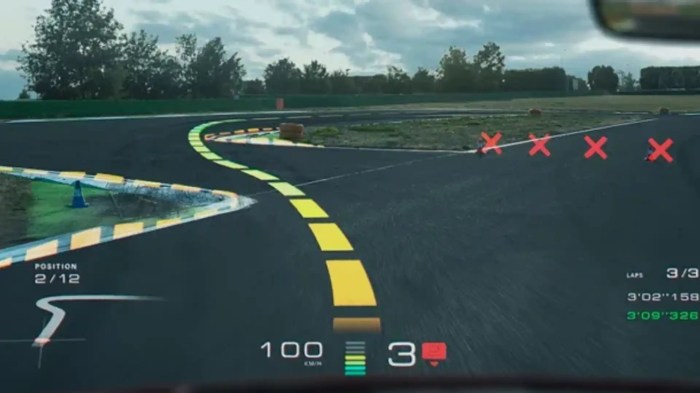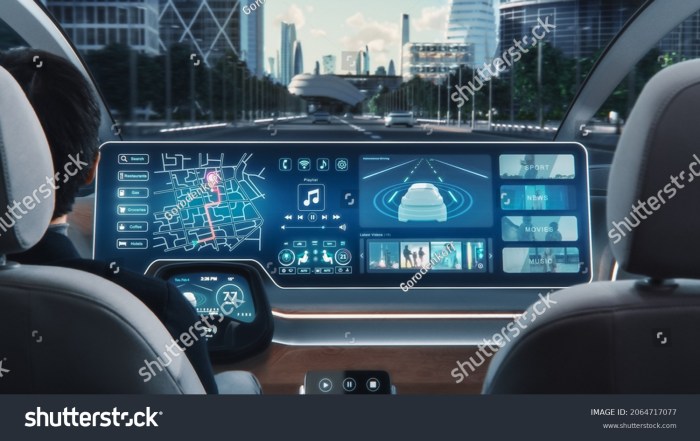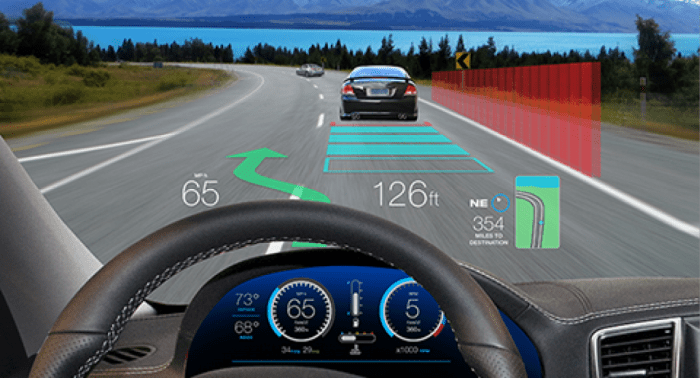Augmented reality dashboards in 2025 EVs? Think beyond just speedometers. We’re talking holographic displays projecting vital info directly onto your windshield, seamlessly integrating navigation, battery life, and even warnings right into your line of sight. It’s a total game-changer for the driving experience, promising a safer, more intuitive, and frankly, way cooler way to get around.
This leap forward isn’t just about flashy visuals; it’s about smarter, safer driving. Imagine having real-time hazard alerts projected onto the road ahead, or a heads-up display guiding you through complex intersections. This tech is poised to revolutionize how we interact with our vehicles, transforming the mundane commute into something far more engaging and efficient. We’ll dive into the tech, the user experience, and the challenges that lie ahead in bringing this vision to life.
Technological Advancements in AR Dashboards for 2025 EVs

The automotive industry is on the cusp of a revolution, with augmented reality (AR) dashboards poised to redefine the driver experience in 2025 electric vehicles (EVs). Expect significant leaps in display technology, sensor integration, interface design, and haptic feedback, creating a safer and more intuitive driving environment. This evolution will be driven by advancements in computing power, miniaturization, and sophisticated algorithms.
AR Display Technology Evolution
By 2025, we can anticipate AR dashboards boasting significantly higher resolutions than current models, potentially exceeding 4K for the main display. This will allow for crisper, more detailed overlays onto the real-world view, enhancing the clarity and accuracy of navigation instructions, speed limits, and other critical information. The field of view (FOV) will also expand, providing a wider perspective for AR elements and reducing the need for drivers to shift their gaze excessively.
Furthermore, advancements in processing power, likely fueled by more efficient and powerful system-on-a-chip (SoC) technology, will enable smoother, more responsive AR overlays with minimal lag, a critical factor for safety. For example, imagine a system capable of seamlessly integrating real-time traffic updates directly onto the windshield, dynamically adjusting the route based on congestion without distracting the driver.
Sensor Integration Advancements
The accuracy and sophistication of AR dashboards depend heavily on robust sensor integration. We anticipate seeing more sophisticated camera systems, capable of capturing higher-resolution images and utilizing advanced computer vision algorithms for object recognition and scene understanding. Lidar technology, while still relatively expensive, will likely find its way into higher-end EVs, providing highly accurate depth information for more realistic and immersive AR overlays.
Radar systems will continue to play a vital role in detecting obstacles and providing crucial data for driver-assistance features, all seamlessly integrated into the AR dashboard interface. Think of a system that uses lidar to precisely measure the distance to the car in front, displaying a warning in the driver’s field of view before the traditional warning systems even activate.
AR Interface Design Considerations
The design of the AR interface is crucial for both user experience and safety. Different approaches exist. One approach involves projecting information directly onto the windshield, providing a heads-up display (HUD) effect. Another involves integrating AR elements into a dedicated display screen, allowing for more complex and interactive interfaces. The key is to minimize distraction and cognitive load.
Effective interface design prioritizes clarity, simplicity, and the judicious use of AR elements, only displaying information that is essential for the current driving situation. A well-designed system might prioritize critical information such as warnings of imminent collisions while relegating less important information to a less prominent position. The focus will be on intuitive and non-intrusive displays, ensuring safety.
Haptic Feedback Integration
Haptic feedback is poised to significantly enhance the interaction with AR dashboards. By providing tactile sensations, haptic feedback can supplement visual cues, drawing attention to critical information without requiring the driver to look away from the road. For example, a subtle vibration in the steering wheel could alert the driver to an impending lane departure, while a more pronounced vibration could indicate a potential collision risk.
Imagine 2025: your EV’s augmented reality dashboard shows real-time energy consumption, maybe even suggesting optimal charging times based on your schedule. But before you can even think about that sweet AR interface, you’ll need a charger, and figuring out the cost is key. Check out this resource on the Cost to install solar-powered EV charger 2025 to plan your setup.
Then, back to that rad AR dashboard – it’ll totally change how you interact with your ride.
This multi-sensory approach to information delivery can significantly improve safety and reduce driver workload. Imagine a system that uses haptic feedback to guide the driver’s hand during lane changes, providing subtle directional cues.
User Experience and Safety Implications of AR Dashboards

Augmented reality (AR) dashboards in 2025 EVs promise a revolutionary leap in driver information and interaction, but their successful integration hinges on prioritizing user experience and safety. A poorly designed AR system can be more distracting and dangerous than a traditional dashboard, while a well-designed one can significantly enhance situational awareness and road safety. This section explores the crucial interplay between user interface design, potential distractions, and safety enhancements in AR dashboard technology.
AR Dashboard User Interface Design for Safety and Intuitive Navigation
Effective AR dashboard design necessitates a user-centered approach, prioritizing crucial information and minimizing cognitive load. The following table illustrates a potential interface structure, focusing on clear presentation and easy access to critical data:
| Data Category | Display Method | Visual Representation | Interaction Method |
|---|---|---|---|
| Speed | Projected onto the windshield near the driver’s line of sight | Large, easily readable numerals | Voice command confirmation or minimal glance |
| Navigation | AR overlay on the road ahead | Simple arrows and directional cues, minimal text | Head-up display with subtle haptic feedback for turns |
| Warnings (Collision, Lane Departure) | Bright, attention-grabbing visuals within the driver’s peripheral vision | High-contrast color scheme and clear icons | Audible alerts in conjunction with visual cues |
| Vehicle Status (Fuel, Battery) | Small, unobtrusive icons in the lower corner of the windshield | Simple, easily understood icons with numerical data on demand | Voice command or steering wheel controls |
This design emphasizes a layered approach, presenting critical information prominently while relegating less urgent data to less visually intrusive areas. The use of simple icons, minimal text, and a consistent color scheme enhances readability and reduces cognitive load.
Potential Distractions Caused by AR Dashboards and Mitigating Design Strategies
AR dashboards, while offering significant benefits, present a potential for distraction. Overly complex animations, excessive information density, and poorly placed visual elements can divert the driver’s attention from the road. Mitigating these distractions requires careful consideration of visual clutter and the integration of eye-tracking technology. For example, the system could automatically dim or reduce the complexity of displayed information if the driver’s gaze is not focused on the road ahead.
Imagine 2025 EVs with augmented reality dashboards showing real-time energy consumption, overlaid on a cool 3D map. To snag that sweet ride and maybe even get some cash back, you’ll need to check the requirements for the Federal EV tax credit eligibility 2025 —it’s all about battery sourcing and assembly location. Knowing the rules beforehand helps you make the most of those futuristic AR features, right?
Furthermore, haptic feedback could be used to alert the driver to critical information without requiring them to take their eyes off the road. Finally, the system could learn driver preferences and adapt the displayed information accordingly.
AR Dashboards for Enhanced Driver Awareness and Safety Features
AR dashboards can significantly enhance driver awareness by overlaying relevant information directly onto the driver’s view of the road. For instance, a heads-up display could project information about approaching vehicles, pedestrians, and potential hazards, providing drivers with a more comprehensive understanding of their surroundings. Similarly, AR could augment blind-spot monitoring systems by projecting virtual representations of vehicles in blind spots directly onto the driver’s view, reducing the risk of accidents.
Furthermore, the system could dynamically adjust the display based on weather conditions, providing drivers with more context-aware information in challenging environments. Think of a system that highlights potential skid zones on icy roads or enhances visibility in heavy rain or fog.
Challenges in Adapting AR Dashboard Interfaces to Different Driving Conditions
Adapting AR dashboard interfaces to diverse driving conditions like bright sunlight or nighttime presents significant challenges. In bright sunlight, the AR projection might be washed out or difficult to see. Solutions include utilizing higher-brightness projectors and implementing adaptive brightness controls that adjust the projection’s intensity based on ambient light levels. Conversely, at night, the AR display could be too bright and distracting.
This requires careful calibration of brightness and contrast to ensure optimal visibility without causing glare or eye strain. Furthermore, the system needs to adapt to different weather conditions, such as rain, snow, or fog, to maintain consistent performance and clarity. For instance, the system could automatically adjust the contrast and brightness to compensate for reduced visibility in fog.
Integration of AR Dashboards with EV Features: Augmented Reality Dashboards In 2025 EVs

AR dashboards in 2025 EVs promise a revolutionary leap in driver experience, going far beyond simple information displays. They represent a sophisticated integration of various vehicle systems, creating a more intuitive and safer driving environment. This seamless integration is key to unlocking the full potential of these advanced interfaces.The ability of AR dashboards to integrate with various EV features is transformative.
By intelligently overlaying digital information onto the real-world view, the dashboard becomes a dynamic and contextualized interface, enhancing both convenience and safety. This integration goes beyond simple data presentation; it actively assists the driver in making informed decisions.
AR Dashboard Integration with Advanced Driver-Assistance Systems (ADAS)
Imagine this: your lane departure warning system isn’t just a beeping sound; instead, a subtle, glowing red line appears on your AR dashboard, clearly indicating the lane boundaries and your vehicle’s position relative to them. Similarly, adaptive cruise control could be visualized with a dynamic representation of the distance to the car ahead, changing color to reflect the safety margin.
Blind-spot monitoring could project virtual “ghost cars” into your peripheral vision, alerting you to vehicles you might otherwise miss. These features, combined with augmented reality, offer a far more intuitive and less distracting warning system than traditional methods. For instance, a pedestrian detection system could highlight pedestrians in your path with a clear visual cue on the AR dashboard, allowing for a quicker and more effective reaction.
Real-time EV Battery, Range, and Charging Status Display
AR dashboards can provide a constantly updated visual representation of your EV’s battery life. Instead of just a percentage number, you might see a graphical representation of the battery, with cells lighting up or dimming to reflect the remaining charge. Range prediction, a crucial aspect of EV ownership, could be displayed as a dynamic map overlay, showing your current range and potential stops along your route.
Charging status information can be seamlessly integrated, showing charging speed, estimated time to full charge, and even a visual representation of the charging process on the dashboard. For example, a Tesla-like charging progress bar could be dynamically overlaid onto a visual representation of the charging connector, giving the driver a clear and intuitive understanding of the charging process.
AR Dashboards for Navigation and Route Optimization
Navigating with an AR dashboard is a completely different experience. Instead of a small map in a corner, directions are overlaid directly onto the real-world view through the windshield. Turns are indicated with clear, animated arrows projected onto the road ahead, eliminating the need to constantly glance down at a separate navigation device. Route optimization can be dynamically displayed, highlighting alternative routes in real-time based on traffic conditions, road closures, or even charging station availability.
For instance, the system could highlight a slightly longer but faster route due to unexpected traffic congestion, visually showing the estimated time saved. This allows drivers to make informed decisions on the fly, enhancing efficiency and reducing stress.
AR Dashboard Interaction with Infotainment and Vehicle Functions
AR dashboards are not limited to safety and navigation. They can also provide a user-friendly interface for interacting with the vehicle’s infotainment system and other functions. Imagine controlling the climate control by simply touching virtual sliders projected onto the dashboard, or adjusting the audio settings using intuitive graphical representations. Vehicle settings, such as lighting and driving modes, can also be accessed and modified through intuitive AR interfaces, all without taking your eyes off the road.
This integrated approach minimizes distraction and allows for a more seamless and enjoyable driving experience. For example, selecting a different driving mode could visually change the display on the dashboard, indicating the chosen mode with a clear visual cue.
Data Visualization and Information Presentation in AR Dashboards
Augmented reality (AR) dashboards in 2025 EVs offer a revolutionary approach to presenting vehicle information. By overlaying digital data onto the driver’s real-world view, AR dashboards aim to reduce driver distraction and improve situational awareness. Effective data visualization is crucial for realizing this potential. The key is to present critical information clearly, concisely, and intuitively, without overwhelming the driver.The effective presentation of data in an AR dashboard requires careful consideration of several factors.
These factors include the organization of information, the use of visual cues, and the integration of data with the driver’s immediate surroundings. The goal is to create an intuitive and seamless user experience that enhances safety and driving efficiency.
Organization of Data Points in an AR Dashboard
A well-designed AR dashboard organizes information logically and prioritizes critical data. The following table provides a sample layout for key data points. Note that the specific placement and appearance would be highly customizable based on the driver’s preferences and the vehicle’s context.
| Data Point | Visual Representation | Location on Dashboard |
|---|---|---|
| Speed | Large, clear digital numeral overlaid on the road ahead | Center of the windshield, slightly below eye level |
| Navigation | Arrows and directional cues projected onto the road | Overlaid on the road ahead, dynamically updating |
| Battery Level | Battery icon with percentage indicator, possibly animated to show charging/discharging | Lower right corner of the driver’s field of view |
| Warnings | Color-coded icons and alerts, with haptic feedback for critical warnings | Strategically placed based on the severity of the warning; for example, a tire pressure warning might appear near the relevant tire. |
Enhancing Visualization of Complex Data with AR
Augmented reality significantly enhances the visualization of complex data like energy consumption and regenerative braking. Instead of abstract graphs or numbers, AR can create a dynamic visual representation. For instance, energy consumption could be shown as a heat map overlaid on the vehicle’s surroundings, illustrating energy expenditure based on driving conditions (e.g., uphill sections showing higher energy use).
Regenerative braking could be depicted with glowing lines or visual cues illustrating energy recovery during deceleration. This allows for intuitive understanding of otherwise abstract energy flows.
Improving Presentation of Vehicle Diagnostics and Maintenance Alerts, Augmented reality dashboards in 2025 EVs
AR can transform vehicle diagnostics and maintenance alerts from cryptic codes into easily understandable visuals. Instead of a simple “check engine” light, AR could project an image of the affected component directly onto the dashboard, potentially highlighting the issue with animations or augmented reality overlays. For example, a low tire pressure alert might highlight the affected tire with a visual cue, making it immediately clear to the driver.
This direct and contextualized presentation makes identifying and addressing problems much more efficient.
Use of Visual Cues and Animations for Effective Communication
Effective communication in the AR dashboard environment relies heavily on clear visual cues and animations. Color coding is crucial: green for positive feedback, yellow for warnings, and red for critical alerts. Animations, such as a gradually depleting battery icon or a smooth transition between navigation instructions, make the information more engaging and easier to process. Subtle animations can also draw attention to important updates without being distracting.
For example, a slight pulsating effect could highlight a new navigation instruction, while a more pronounced animation might indicate a critical system failure. The key is to use animation judiciously to enhance, not detract from, the driver’s focus.
Challenges and Future Trends of AR Dashboards in EVs
Okay, so we’ve covered the cool stuff about AR dashboards in 2025 EVs – now let’s get real about the bumps in the road. Implementing this tech isn’t just a matter of slapping some holograms onto a screen; there are some serious hurdles to overcome before we see widespread adoption. We’ll explore the technical, economic, and design challenges, along with some exciting future possibilities.
Technical Hurdles to Widespread Adoption
Several technical challenges need addressing for AR dashboards to become commonplace in 2025 EVs. High-resolution displays capable of handling complex AR overlays are crucial, but their power consumption needs to be optimized to extend battery life. The processing power required to render these graphics in real-time is significant, and the system needs to be robust enough to handle unexpected inputs and maintain responsiveness even under demanding conditions, like bright sunlight.
Furthermore, ensuring accurate projection and alignment of AR elements onto the driver’s field of vision, especially considering different seating positions and driving styles, is a complex calibration problem. Finally, the integration of various sensor data (GPS, speed, vehicle diagnostics) needs to be seamless and reliable, and data security must be paramount to prevent hacking or data breaches.
Economic Factors Influencing Development and Implementation
The cost of developing and implementing AR dashboard technology is a major factor limiting its widespread adoption. High-resolution displays, powerful processors, advanced sensors, and the software development necessary for sophisticated AR overlays are all expensive. The manufacturing process needs to be cost-effective to make AR dashboards accessible to a broader range of EV buyers. Moreover, the return on investment for automakers needs to be compelling, requiring a strong market demand and convincing evidence of improved driver experience and safety.
The potential for increased manufacturing costs and higher vehicle prices could limit market penetration, especially in the budget-conscious EV segment.
Future Trends in AR Dashboard Design
The future of AR dashboards in EVs is bright, with several exciting trends emerging. The integration of AI is poised to revolutionize the user experience. AI-powered systems could personalize the dashboard based on individual driver preferences, adapting the layout, information displayed, and even the AR overlays to optimize for safety and comfort. For example, an AI could learn a driver’s typical route and proactively display relevant information like upcoming traffic or charging stations.
Furthermore, haptic feedback could be integrated to enhance the immersive experience and provide additional cues without relying solely on visual information. This might involve subtle vibrations in the steering wheel or seat to alert the driver to important notifications or changes in the environment. Advanced gesture recognition could allow for more intuitive control of the AR interface, reducing driver distraction.
Improving Driver Comfort and Reducing Driver Fatigue
AR dashboards offer a significant potential for improving driver comfort and reducing fatigue. By intelligently presenting information, reducing the need for drivers to constantly scan multiple gauges, and offering personalized settings, AR systems can create a less stressful driving environment. For instance, AR overlays could project navigation instructions directly onto the road ahead, eliminating the need for drivers to look down at a separate screen.
Furthermore, by customizing the dashboard’s brightness and color schemes to match ambient lighting conditions, AR systems could reduce eye strain. Adaptive displays that automatically adjust to the time of day and weather could further improve comfort and reduce fatigue. The integration of biometrics could even allow the system to detect signs of driver fatigue and provide warnings or suggestions for breaks.
Imagine a system that recognizes drowsy driving patterns and subtly alters the dashboard display to increase alertness.
Final Thoughts
Ultimately, augmented reality dashboards represent a significant step forward in automotive technology. While challenges remain in areas like cost and widespread adoption, the potential benefits – improved safety, enhanced driver experience, and seamless integration with advanced vehicle features – are undeniable. As we move closer to 2025, the integration of AR dashboards into EVs promises to redefine the driving experience, making it safer, more efficient, and more enjoyable than ever before.
Buckle up, the future is here.









